General Comments
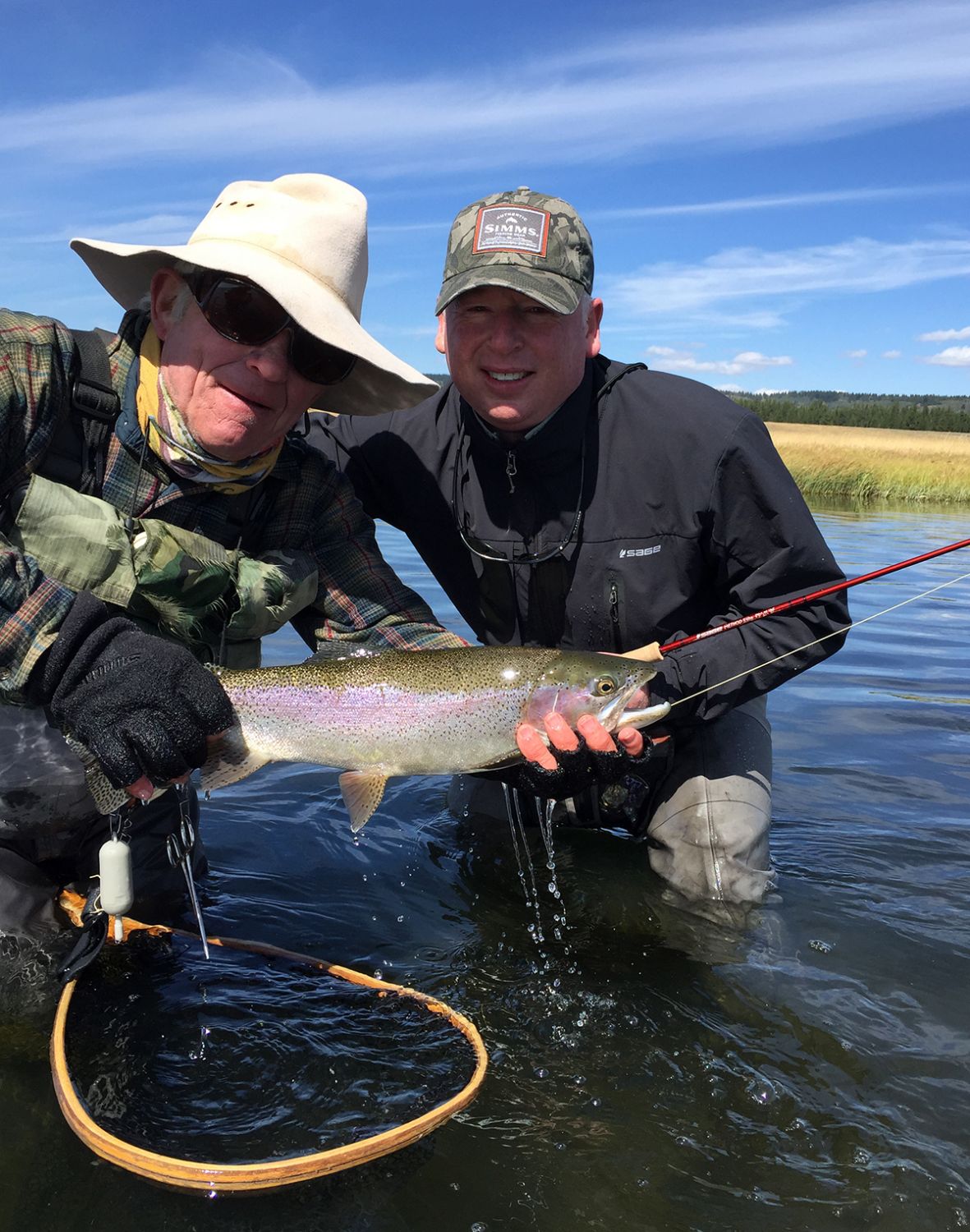 2015 provided the eighth straight year of good fishing on the Ranch; however, there were more periods of tough fishing than in any summer since 2007. I invested 485 hours with clients, or on my own, on the Ranch from 15 June to 15 September. We landed 86 good Ranch fish. That is a dramatic reduction from the 118 fish we took in 2014; nevertheless, we enjoyed many days of wonderful dry fly fishing.
2015 provided the eighth straight year of good fishing on the Ranch; however, there were more periods of tough fishing than in any summer since 2007. I invested 485 hours with clients, or on my own, on the Ranch from 15 June to 15 September. We landed 86 good Ranch fish. That is a dramatic reduction from the 118 fish we took in 2014; nevertheless, we enjoyed many days of wonderful dry fly fishing.
The vast majority of the fish we landed were in good condition. We had many deep, heavy fish. The percentage of fish over 20 inches was remarkably high with 33 fish of 20 inches or over; however, there were few fish of 22 inches or longer. We had many that were right at 19 inches in length. There must be something about the population that has contributed to the high number of fish that are19 inches long. Our largest fish was a deep 23 inch male. (To put the 23 inch fish in perspective, despite the high number of fish we have landed of 20 inches or over, we have only landed two of 23 inches in the last three years; moreover, that standard of only two fish of 23 inches or more each three years—on dry flies—has held up, consistently, over my thirty-three years of fishing the Ranch.)
The only sign of pathology was that three fish had ulcer like scars on their gill plates. I have seen comparable "scars” on large fish in every year I have fished the Ranch. (The use of the term "scar” is mine, and I am not a biologist.) There were very few fish—significantly fewer than in an average year—that were thin.
Of critical negative importance in the context of our fishing were the high water flows, which were accompanied by discolored water for almost precisely three weeks in July. The high flows took place from 7 July to 24 July. Fishing was terrible during the entire period. A skilled angler I have guided for seven years failed to find a target in a long, eleven hour day of searching three different sections of the Ranch. Another friend allocated two and one half days to fishing the water and never made a cast.
Two other elements were defining features of the 2015 Ranch season: first, was the alteration in timing of many of our aquatic insect hatches. We had Green Drakes, in numbers, before the Ranch opened. The best Brown Drake evening was 16 June, a date that is fourteen days earlier than our typically best Brown Drake date. It seems reasonable to assume that the dry, warm weather in April and June influenced the early dates for the Drake hatches. At the other extreme of odd bug timing was my best day for Flav duns—when two skilled, and hard working, clients landed seven rainbows of eighteen inches or better—was the 8th of August. (The eighth of August is the latest date I have had good Flav fishing.)
A second defining feature of the 2015 season was a significant increase in fishing pressure after July 7. Typically, we see a dramatic decrease in pressure after the first week of July. This year we had pressure on all sections of the Ranch for the entire summer and early fall. I suspect that poor fishing, high temperatures, and low water levels in other parts of Idaho, Montana and Wyoming contributed to the pressure. (Another, important, indication of increased pressure was the number of fish that were landed with multiple hook scars. I saw twice as many fish with multiple hook scars than I have in any other year.)
The Early Summer (15 June- 6 July)
The fishing was superb when the Ranch opened. Not only were there Green Drake and Brown Drake duns but many spinners of both species of mayflies. As has been the case for the last two years, there was great Green Drake spinner fishing. The Brown Drake spinners were the best we have had in all my years on the Ranch. They were not only seen in good numbers on the section of the Ranch that typically produce Brown Drakes, but we also had good fishing with the spinners at the top of the Ranch. One of the fascinating aspects of the unusual Brown Drake spinner fishing on the upper Ranch was that you did not need to see any on the water to get the fish to take them. The unusually good Grey Drake fishing we had in 2014 was not repeated in 2015.
My notes indicate we had good Green Drakes between the 15th and 24th of June—with particularly fine fishing on the 19th, 20th, 21st, 22nd, 23rd, and 24th. We had good Brown Drakes from 16 June to 23 June, with great fishing on the 16th, 17th and 18th.
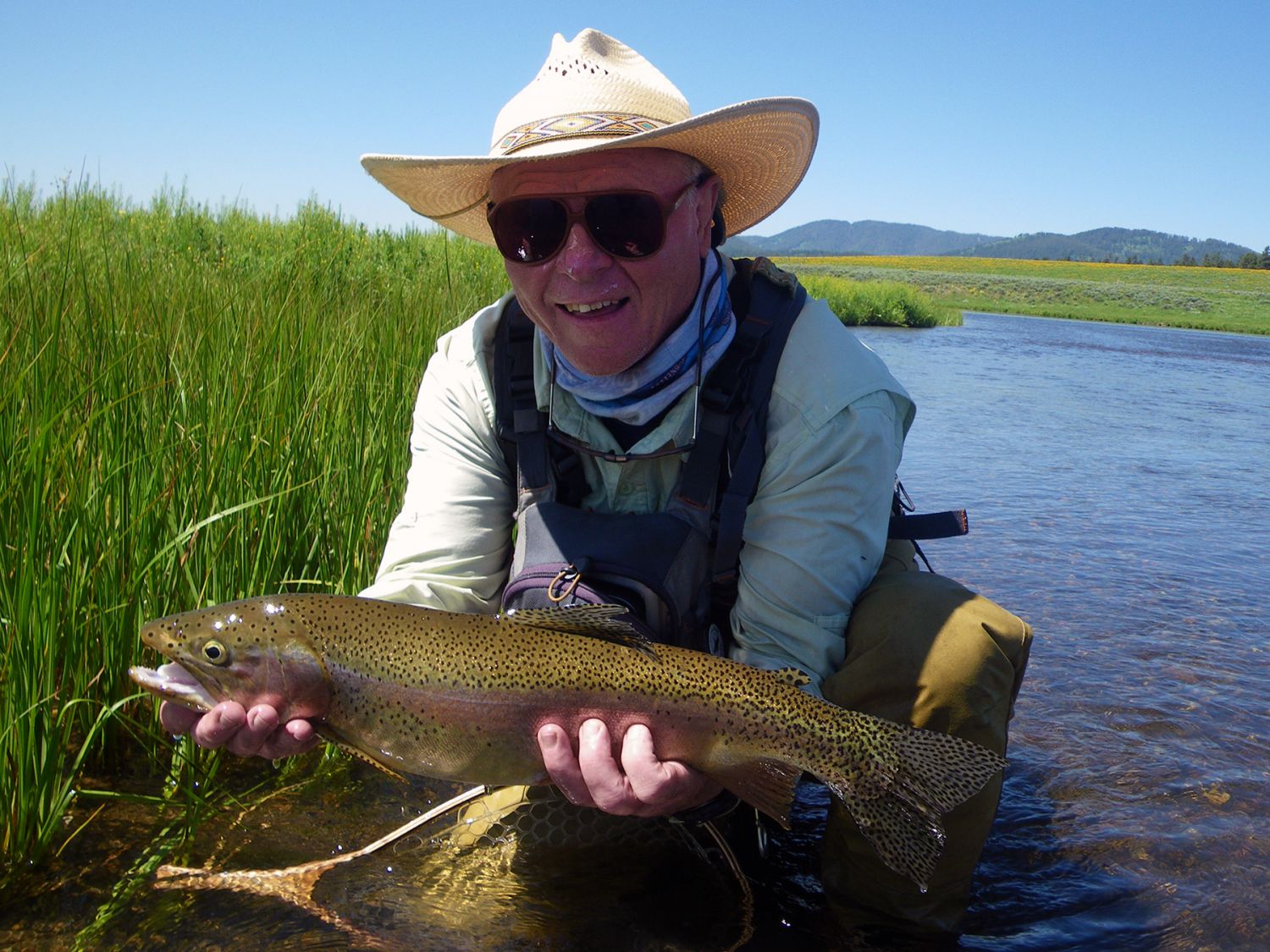 My good friend Gary Franke—known as "The Coach” to many Ranch regulars—had an epic Brown Drake evening. On 16 June, in the Flats Above the Channels, Gary hooked ten rainbows and landed eight. The smallest was 17 inches in length and the largest 22. The fact Gary accomplished the feat in the small window of a Brown Drake evening is remarkable.
My good friend Gary Franke—known as "The Coach” to many Ranch regulars—had an epic Brown Drake evening. On 16 June, in the Flats Above the Channels, Gary hooked ten rainbows and landed eight. The smallest was 17 inches in length and the largest 22. The fact Gary accomplished the feat in the small window of a Brown Drake evening is remarkable.
The fine Drake fishing was supplemented by good PMD hatches. Often, when both Green Drakes and PMDs were on the water the rainbows would be taking the smaller mayflies.
The late part of the Early Season, from 25 June to 7 July, provided decent Flav dun fishing in the evenings and Flav and PMD spinner fishing in the mornings. (The Flav fishing was not as good as it has been in recent years but my clients and I landed 13 good fish on Flav duns.)
As has been true in the last few years, we had no significant caddis fishing during the period. In the 1980s we had consistently superb caddis fishing during the Early Summer. It would be interesting to investigate why there has been such a dramatic decline in the Early Summer caddis fishing.
The only other bug that provided fishing during the period was the ever dependable flying black ant. The remarkable insect is taken by some of our most selective rainbows.
The Mid Summer Season. (7 July- 27 July)
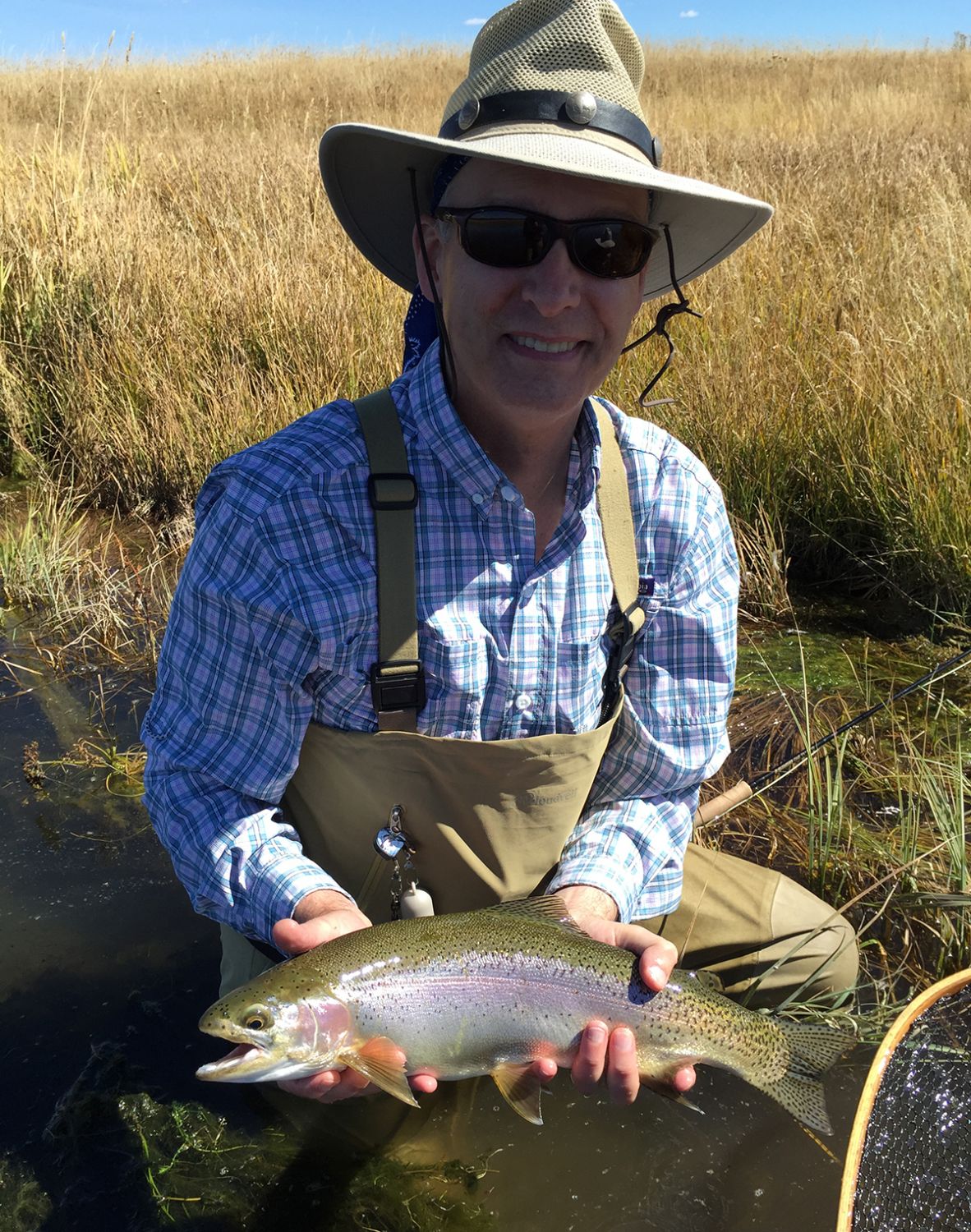 The mid-summer fishing was a disaster. Early in the period we had some decent Flav dun fishing, but even that was not up to the standards of the last few years. Increased flows began about 7 July and continued for almost three weeks. What was particularly disturbing was that, for the first time, we had significantly discolored water accompanying the high water. The original flow increases were from 1400 to 1800 c.f.s.
The mid-summer fishing was a disaster. Early in the period we had some decent Flav dun fishing, but even that was not up to the standards of the last few years. Increased flows began about 7 July and continued for almost three weeks. What was particularly disturbing was that, for the first time, we had significantly discolored water accompanying the high water. The original flow increases were from 1400 to 1800 c.f.s.
The worst of the high flows occurred between 21 and 24 July when the "flushing” of a downriver dam resulted in flows of 2200 cfs and above. The fishing was essentially non-existent. I was proud that TroutHunter suggested that clients cancel, or postpone, trips during the period.
My first productive day of fishing after the high flows was 26 July when clients hooked several nice fish on Calibaetis spinners. So, we had essentially 21 days of flows that destroyed our fishing. One angler with extensive fly fishing experience suggested the economic costs of the high flows to the recreational businesses in Island Park may have been $100,000.00 a day.
The end of the Mid Summer period provided a few fine days of fishing thanks to the Honey Ants and Pale Morning Duns. We had good Honey Ants on 20 and 25 July—those are very early dates for the bugs. We also had good PMD dun fishing on sections of the Ranch on 25 though 27 July. (27 July is the last day of he Mid Summer Period.)
To put the difficulty of the Mid Summer in perspective, I had 8 days, when neither my clients nor I landed a fish.
The Late Summer (28 July- 25 August)
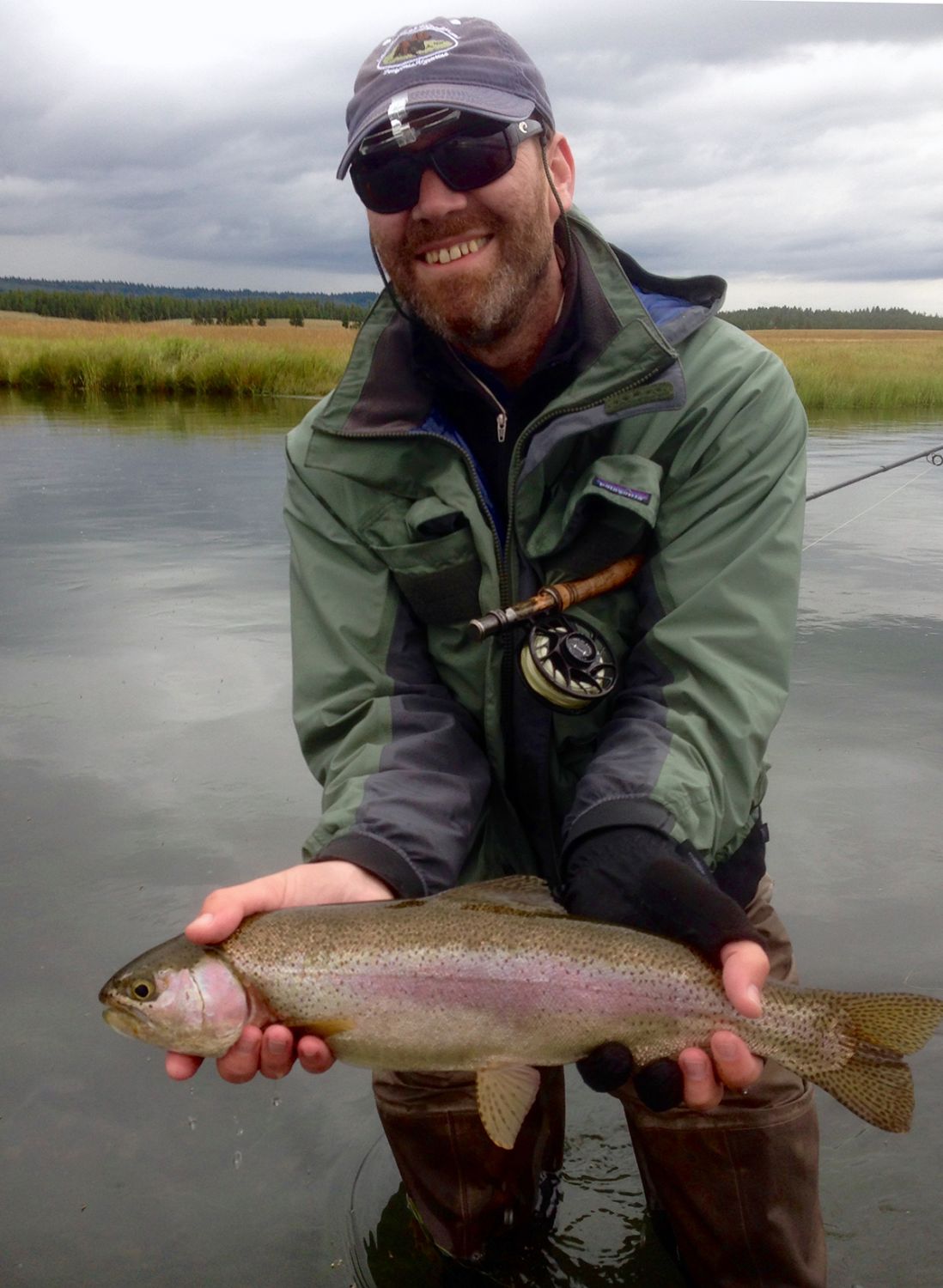
Thankfully, the late summer provided fine fishing. It began with good PMD duns and Honey Ants and ended with good spinner and hopper fishing. We had Honey Ants a remarkable nine times in the Late Season. The dates were 30 and 31 July and 3, 10, 11, 12, 24, 25, and 26 August. (In my thirty-three full summers on the Ranch, that is the first time I have ever seen the ants three days in a row, twice. When you add the two days during the Mid- Summer Period, you have a total of eleven days of Honey Ant fishing. That is the most for any year I have fished the Ranch.
We also had good Calibaetis spinners early in the period. The hoppers started in the second week of the period and provided good fishing for the remainder of my season. We ended up with a number of multiple fish days on hoppers on several different sections of the Ranch.
The most productive guide trip of the summer was special. Two physicians, Dr, Florian Nickisch and Dr. Coleman Herrod, from Salt Lake City invested a long day and had spectacular Flav dun fishing late on the 8th of August. What was most amazing about the evening was that my two skilled clients landed every one of the seven good fish they hooked. Six of the seven fish were hot Ranch rainbows. (One took my client into his backing, and all six fought with the speed, strength, and stamina characteristic of the best of our Ranch fish.) What made the landing success so special was not only the strength and speed of the fish, but also the fact my clients were on light tippets—they were not hopper fishing with 3X tippets. The guys were on 5.5X TroutHunter tippet material. I had a chance to fish the day after our great evening. I sent my clients an email telling them I had hooked six great fish on Honey Ants and only landed one.
We began to get good Trico dun and spinner fishing about 20 August. (That is a bit earlier than normal on the Ranch.) We also begin to see Mahogany duns and a variety of spinners.
I have never seen Ranch fish tougher on a variety of bugs than they were in Bonefish during the period and extending into September. It is true that when our Wood Road fish are taking Pale Morning Dun nymphs they are as tough as any in the world; however, in this case, we had fish taking Calibaetis spinners, Mahogany duns, and Trico duns and spinners and they were super tough on all the bugs. Good imitations of the bugs I have mentioned usually fool our fish—the Bonefish rainbows would not eat them. What made the toughness of the Bonefish rainbows particularly interesting is that fish in the flats below Millionaires and in the Channels were much easier to hook on the same types of flies during the same period and both areas received comparable fishing pressure. It may have been the nature of the water—in the context of the speed and clarity—that made it consistently so tough in Bonefish.
The Fall Season (28 Aug- 15 Sep)
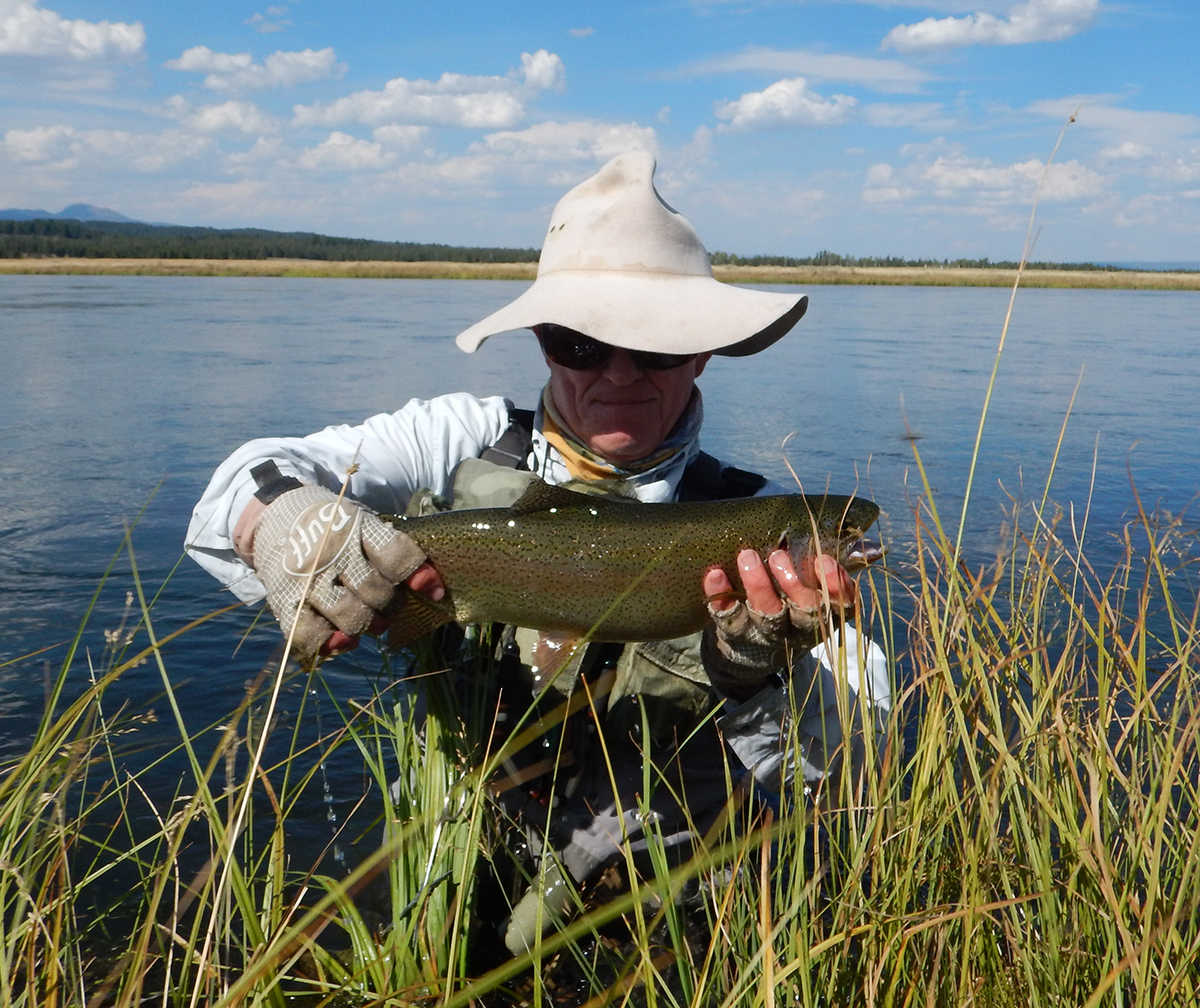
The last days of August and the first 15 days of September were disappointing. Last year, the period afforded wonderful fishing. This year, we had good Blue Wing Olives, Tricos, and hoppers, but the wind blew a gale most of the time. The Mahoganies were not as good as they were last year but they were still seen with frequency. The disparity with the fishing in 2014 was dramatic. As one example, last year my clients and I landed twenty-three good fish—the majority in September—on Mahoganies. This year we took three.
We had good numbers of both Trico duns and spinners, but the fish were very tough and the wind often made the fishing exceedingly difficult. One evening, there were great numbers of both BWO duns and spinners on the Flav Bank, below the Log Jam, but the wind must have been blowing 25 miles per hour. I spent two frustrating hours trying to get my fly over multiple fish rising on the bank. I hooked two and landed one and about went crazy watching the fly get blown off my targets.
Candidly, fighting the constant strong winds was exhausting. Even my youngest clients said the wind wore them out. Some of our longest days had us flailing with tiny Blue Wing Olive imitation in violent winds. It was neither pretty, nor productive dry fly fishing.
Despite not having many hot days during the period, the constant winds blew hoppers into the water and we took advantage of it. We landed many beautiful fish on hoppers—12 during this 28 Aug to 15 Sep period—including the best fish of the summer, a deep, 23 inch male with a pronounced kype. Yes, we were constantly having to take pieces of floating grass off our hoppers—in some cases cleaning the fly after every cast—but we hooked many good fish.
Special Questions about the Fishery that Emerged in 2015
1-Is the Significant Decline in Whitefish on the Ranch Worthy of Study?
This August, I found a dead whitefish In Bonefish Flats. After looking at the fish, I realized I had not held a whitefish for years. I went back to my journal I keep for all my trips and personal fishing. My current journal maintains records since 2013. During the three seasons, concluded on 15 September 2015, my clients and I landed 254 rainbows of over 17 inches and not a single whitefish. It is true I fish dry flies exclusively with my clients; however, in the 1980s you would hook many whitefish on dry flies. In fact, it was difficult to keep them off Brown Drake imitations.
My record of not hooking whitefish is not because I developed special skills in differentiating between the rises of trout and whitefish. I frequently made mistakes in differentiating between the rises.
The disturbing fact is there has been a dramatic reduction in the population of whitefish on the Ranch. The evidence is not exclusively related to a failure to hook whitefish. In 1983, my wife Nell and I were astounded by the large schools of whitefish Rick Lawson showed us in the deep water off Piney Point. They are not there today.
The decrease in whitefish became precipitous after the 1992 silt disaster. Has there been any attempt to see what the nature of the whitefish population on the Ranch water is today? If the numbers have dropped dramatically, it is important to ask why. Is it possible that the respiratory physiology of the whitefish may be more sensitive to silt than that of the rainbow? If that is true, the whitefish may provide us with data that has implications for better understanding the health of our river.
2- Are the Predatory Pelicans a Problem?
Many anglers expressed concern about the numbers and aggressiveness of pelicans this summer. I saw groups of as many as 23 on the Top of the Ranch. On two occasions, pelicans pursued rainbows I hooked. In both cases, it was uncanny how quickly the big birds responded to my hooking a fish, and how relentless they were in pursuing the rainbows. My screaming was effective in convincing the pelicans not to press home their pursuit of my rainbows; however, Rene Harrop’s son Shane, had a pelican chase a fish until he was so close that he had to hit the bird with his rod.
It amazes to me how effective the individual pelican can be pursuing our large rainbows. It seems as if the large, bright white bird would be easy for our wary trout to avoid. That is not the case. The pelicans are often successful in individually stalking trout. I have seen many 20 inch class fish taken by pelicans hunting alone.
I pointed out a large group of pelicans to a client from Canada. He said that pelicans had a dramatically negative impact on the fishing of the famed Bow River in Alberta, Canada. I think we need to watch the pelicans and see if their numbers—and impact on our fish—will increase in the future.
3-Will the Aquatic Vegetation Growth, we have seen in the Last Three Years in August and September Occur Every Year?
The vegetation growth has been a negative for anglers because it makes it makes it much more difficult to wade and land fish. It is also very frustrating to have to constantly clean vegetation from your flies. In the last three years, the growth became a significant hindrance in August and the large blocks of weeds do not begin to break loose until mid-September.
Some anglers, many with considerable experience on the Ranch, have expressed deep frustration about the weeds. (A few anglers left the Ranch this summer saying the weeds were driving them crazy.)
It was uncanny how quickly the vegetation could collect in certain sections of the Ranch. By the second week of September, The Islands were choked with weeds. I had a guide trip on 9 September and we were able to hook a couple of rainbows in two narrow—perhaps fifteen feet wide— open channels in the middle of the Islands. The next day, I retuned with two different clients and both channels were completely closed off with weeds.
It would be interesting to get a perspective from fisheries biologists on the aquatic weed situation. Perhaps we will have to live with, and even celebrate, the weeds if the biologists tell us the growth is a positive in the context of the health of the fishery.
4- When will Improvements be made on the Irrigation Canal?
Anglers were thrilled to hear that the Henry’s Fork Foundation is poised to implement action on the Irrigation Canal. It is critical that it be done soon. This year silt continued to pour into the river from both the "Irrigation Outlets at the Top of the Ranch; moreover, it was reported to me, for the first time, that 20 inch class rainbows were being trapped in the canal. The loss of such fish—that the biologist tell us take seven or eight years to achieve their size—is a reason for concern for all who love the Ranch.
Many of my clients, some of whom have the greatest potential to help the Foundation, are very concerned about how long the Canal problem has been allowed to persist. In that context, the worst water/silt release took place in 2006; moreover, those of us who have taken the time to study the satellite map images of the river can see disturbing changes in the hydrology of the river, contiguous to the Canal outlets, as early as 1994. Those images, and comments about the seriousness of the situation they depict, were provided by two environmental professionals, and superb anglers, from the East who fish the Ranch each season. (I am thrilled by the fact that several members of the Henry’s Fork Foundation Board are committed to seeing that the repair of the canal takes place in a timely fashion.)
Looking Forward to 2016
The Dramatic Increase in my Client’s Fish Landed to Hooked Ratio in 2015
Over my 17 years of guiding on the Ranch, my clients have averaged landing approximately 30% of the good fish they hook. In 2014, the weed growth resulted in the number plummeting to 18%. This year, despite the weeds, the figure rose to 41 %. The increase in success was interesting because many of this year’s clients had fished with me in the past.
I am confident the tippet material I had my clients on in 2015 was critical. For the first time, I was forceful in suggesting they use the remarkable TroutHunter fluorocarbon material. Candidly, it is expensive and for years I was sensitive to suggesting clients use it. This year, I was not bashful about encouraging my clients to try it. The reason was I wanted them to hook and land fish. When a client said he wanted to use a different material, I said, "If you use the TroutHunter tippet material your chances of both hooking and landing the fish are dramatically increased.”
Comments on Clients’ Casting
During my seventeen years of guiding on the Ranch, I have had many clients who were skilled anglers; however, it is rare to get an angler that does not have problems meeting the special casting challenges imposed by Ranch fishing. The errors I see most frequently include the following:
1- Holding the rod above their head, or well out to the side of their bodies, when making the casting stroke. Great casters keep their rod holding hand close to their faces and cast with a compact stroke.
2- Not stopping the rod on casting strokes. A dramatic casting mistake is "pushing” rather than stopping the rod at the end of the forward stroke in a vain attempt to generate power. It is the stop of the casting stroke that projects the line with velocity.
3- Making underpowered back casts. A good back cast is the key to a fine forward cast. Most anglers flip the back cast behind them and then try, without success, to generate power on the forward stroke. The fine back cast is made with power and is elevated.
4-Initiating the back cast with too much line on the water. You should strip line in until you have a reasonable amount beyond your rod tip. I like no more than 45 feet of line beyond the rod tip.
5- Starting their back cast with the rod at a 45 degree, or higher, angle from the surface of the water. Initiate the back cast with the rod tip low, just off the water, and strip in line to make sure it is taut, to the end of loading the rod instantly when you initiate the cast.
6- Making no pause between the back and forward cast. Many clients "swish” their rod back and forth. You have to pause to allow the line to unfurl before making your next stroke. The pause is essential.
7- Failing to keep the back and forward casts at angles of 180 degrees to each other. The back cast should be made higher and the forward cast lower, when casting at average ranges.
8- Not making a modest drop in the tip of their rod after completing the forward stroke. The failure to drop the tip of the rod often results in tailing loops.
9- Not allowing the rod to drift after the stop to get the most efficiently shaped loop. Yes, the stop must be solid, but the relaxation of your grip and a modest drift of the rod will result in an even tighter loop.
10- Making too many false casts. One quick, powerful false cast will allow you to dry your fly and /or feed additional line. Every false cast has the risk of alerting trout.
11- Trying to achieve a better drift by extending their rod holding hand toward the floating fly after the cast. The technique is inefficient. You must learn to put slack line in your casts, and develop the skill of feeding line to achieve good drifts.
Improving you casting is critical to your meeting the challenges of the Ranch. Assessing your casts is a great start. First, evaluate your accuracy and examine the loops you are producing—particularly of your back casts—to see if they are tight and consistent. Your assessment of your casting skill should not be based simply, or primarily on how far you can cast. If you have access to a casting club, seek the assessments of skilled casters.
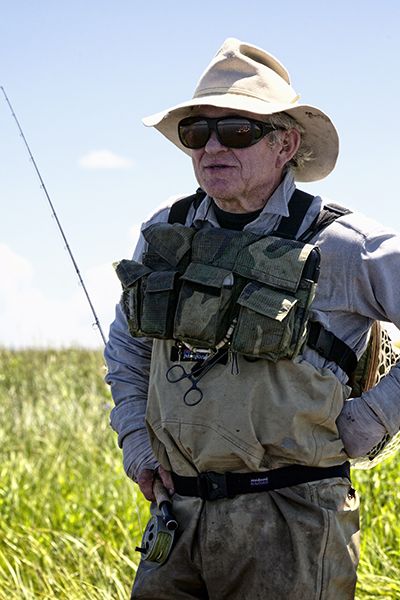
To improve your skills you must practice diligently and read all you can about casting. We are lucky that many skilled teachers have written about the art. Classic books have been published by Mel Krieger, Joan Wulff, Lefty Kreh, and Ed Joworowski. Particularly informative chapters on casting have been written in general books on fly fishing by A J McClane, Charles Ritz, Ted Trueblood, and Lee Wulff. Wonderful articles have appeared in journals written by Steve and Tim Rajeff, Lou Stoner, Tom Morgan, Brant Oswald, and many others. Do not eliminate works because of their age. Each year, I review the sage casting advice offered by the late Ted Trueblood in his book, The Angler’s Handbook published in 1949. Finally, I humbly suggest you look at two relatively recent books on casting that I perceive to be superb and innovative. They are Geroge V. Robert’s "Master the Cast” published in 2005 and Jon Cav’s Performance Fly Casting published in 2011.
John McDaniel is the author of "Fly Fishing the Harriman Ranch of the Henry's Fork of the Snake River Lessons Learned and Friends Made Sight Fishing to Selective Trout" as well as a remarkably detailed fishing map of the Ranch. He is a wade fishing guide specializing in the challenging Harriman Ranch. Please call the shop at 208.558.9900 to set up a day on the Ranch with John.

1 Comment
Nick Maricich
This is great information from a true sportsman to a life long idahoan